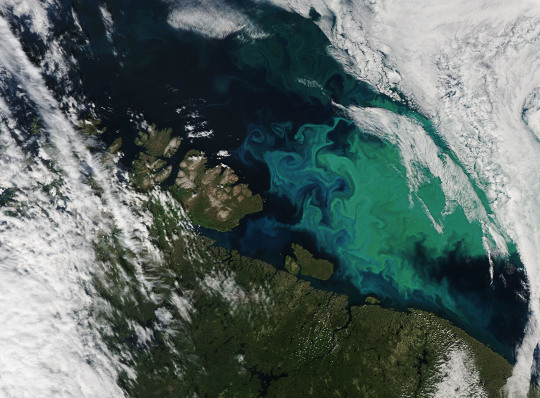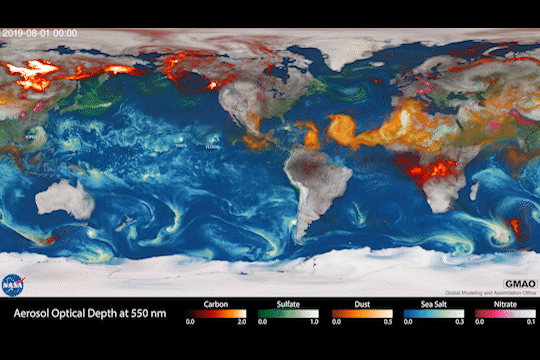#Atmospheric science
Text
As relentless rains pounded LA, the city’s “sponge” infrastructure helped gather 8.6 billion gallons of water—enough to sustain over 100,000 households for a year.
Earlier this month, the future fell on Los Angeles. A long band of moisture in the sky, known as an atmospheric river, dumped 9 inches of rain on the city over three days—over half of what the city typically gets in a year. It’s the kind of extreme rainfall that’ll get ever more extreme as the planet warms.
The city’s water managers, though, were ready and waiting. Like other urban areas around the world, in recent years LA has been transforming into a “sponge city,” replacing impermeable surfaces, like concrete, with permeable ones, like dirt and plants. It has also built out “spreading grounds,” where water accumulates and soaks into the earth.
With traditional dams and all that newfangled spongy infrastructure, between February 4 and 7 the metropolis captured 8.6 billion gallons of stormwater, enough to provide water to 106,000 households for a year. For the rainy season in total, LA has accumulated 14.7 billion gallons.
Long reliant on snowmelt and river water piped in from afar, LA is on a quest to produce as much water as it can locally. “There's going to be a lot more rain and a lot less snow, which is going to alter the way we capture snowmelt and the aqueduct water,” says Art Castro, manager of watershed management at the Los Angeles Department of Water and Power. “Dams and spreading grounds are the workhorses of local stormwater capture for either flood protection or water supply.”
Centuries of urban-planning dogma dictates using gutters, sewers, and other infrastructure to funnel rainwater out of a metropolis as quickly as possible to prevent flooding. Given the increasingly catastrophic urban flooding seen around the world, though, that clearly isn’t working anymore, so now planners are finding clever ways to capture stormwater, treating it as an asset instead of a liability. “The problem of urban hydrology is caused by a thousand small cuts,” says Michael Kiparsky, director of the Wheeler Water Institute at UC Berkeley. “No one driveway or roof in and of itself causes massive alteration of the hydrologic cycle. But combine millions of them in one area and it does. Maybe we can solve that problem with a thousand Band-Aids.”
Or in this case, sponges. The trick to making a city more absorbent is to add more gardens and other green spaces that allow water to percolate into underlying aquifers—porous subterranean materials that can hold water—which a city can then draw from in times of need. Engineers are also greening up medians and roadside areas to soak up the water that’d normally rush off streets, into sewers, and eventually out to sea...
To exploit all that free water falling from the sky, the LADWP has carved out big patches of brown in the concrete jungle. Stormwater is piped into these spreading grounds and accumulates in dirt basins. That allows it to slowly soak into the underlying aquifer, which acts as a sort of natural underground tank that can hold 28 billion gallons of water.
During a storm, the city is also gathering water in dams, some of which it diverts into the spreading grounds. “After the storm comes by, and it's a bright sunny day, you’ll still see water being released into a channel and diverted into the spreading grounds,” says Castro. That way, water moves from a reservoir where it’s exposed to sunlight and evaporation, into an aquifer where it’s banked safely underground.
On a smaller scale, LADWP has been experimenting with turning parks into mini spreading grounds, diverting stormwater there to soak into subterranean cisterns or chambers. It’s also deploying green spaces along roadways, which have the additional benefit of mitigating flooding in a neighborhood: The less concrete and the more dirt and plants, the more the built environment can soak up stormwater like the actual environment naturally does.
As an added benefit, deploying more of these green spaces, along with urban gardens, improves the mental health of residents. Plants here also “sweat,” cooling the area and beating back the urban heat island effect—the tendency for concrete to absorb solar energy and slowly release it at night. By reducing summer temperatures, you improve the physical health of residents. “The more trees, the more shade, the less heat island effect,” says Castro. “Sometimes when it’s 90 degrees in the middle of summer, it could get up to 110 underneath a bus stop.”
LA’s far from alone in going spongy. Pittsburgh is also deploying more rain gardens, and where they absolutely must have a hard surface—sidewalks, parking lots, etc.—they’re using special concrete bricks that allow water to seep through. And a growing number of municipalities are scrutinizing properties and charging owners fees if they have excessive impermeable surfaces like pavement, thus incentivizing the switch to permeable surfaces like plots of native plants or urban gardens for producing more food locally.
So the old way of stormwater management isn’t just increasingly dangerous and ineffective as the planet warms and storms get more intense—it stands in the way of a more beautiful, less sweltering, more sustainable urban landscape. LA, of all places, is showing the world there’s a better way.
-via Wired, February 19, 2024
#california#los angeles#water#rainfall#extreme weather#rain#atmospheric science#meteorology#infrastructure#green infrastructure#climate change#climate action#climate resilient#climate emergency#urban#urban landscape#flooding#flood warning#natural disasters#environmental news#climate news#good news#hope#solarpunk#hopepunk#ecopunk#sustainability#urban planning#city planning#urbanism
13K notes
·
View notes
Text
A mysterious and rapid rise in Legionnaires' disease, a severe bacterial lung infection, has been linked to cleaner air, in a US study of trends in sulfur dioxide pollution.
Puzzled by the lengthy global upsurge in Legionnaires' disease, an atypical form of pneumonia caused by Legionella bacteria, researchers at two US universities and the New York State Department of Health investigated possible environmental factors that could explain the trend in their neck of the woods.
Continue Reading.
229 notes
·
View notes
Text
Exoplanet Heating

WASP-96B is a tidally-locked exoplanet between the size of Saturn and Jupiter. This hot, massive planet lies close to its star, orbiting in less than three-and-a-half Earth days. (Image and research credit: J. Skinner et al.; via APS Physics)
Read the full article
#atmospheric science#exoplanets#fluid dynamics#numerical simulation#physics#planetary science#science#turbulence#vortices
156 notes
·
View notes
Text

Are you sure about that NASA????

#the x files#dana scully#x files#fox mulder#gillian anderson#txf#david duchovny#msr#science#nasa#atmospheric science#academia#graduate student#graduate school#grad student#grad school#this joke is definitely only funny to me#but it’s really really funny to me#so idrc#i’m literally hilarious#and losing my mind
22 notes
·
View notes
Text
Inez Fung

Atmospheric scientist Inez Fung was born in Hong Kong in 1949. Fung is one of the world's foremost experts on climate and the carbon cycle. She is currently a professor of atmospheric science at UC Berkley. Fung has won numerous awards, including NASA's Exceptional Scientific Achievement Medal, and the Carl Gustaf-Rossby Research Medal, the American Meteorological Society's highest honor for atmospheric scientists. She is a member of the National Academy of Sciences, and was a contributor to the Nobel Prize-winning Intergovernmental Panel on Climate Change.
Image source: Whitehouse.gov
#science#scientists#women in science#climate science#atmospheric science#hong kong#woc#women of color#asian-american
7 notes
·
View notes
Text


Pristine OR this Morning Following Yesterday's Mass Exodus
Mar. 28, 2024
The atmosphere is too high in orgone for "flight" today. I have only seen one "plane" so far this morning, very high up with a short trail. Yesterday, they were all flying at once as they made their mass exodus before atmospheric conditions would become too high for their DOR-based technology to handle (deadly radiation from the cell tower arrays on the ground, which energize the flight grid in the sky).
When you start to notice the pattern in heavily gifted places, you'll see that they all fly at once, usually before high OR conditions make it impossible. This is why the chemtrail conspiracy shills say they "spray before it rains." No one is spraying anything. They are using a DOR based form of transportation in our atmosphere and they all go at the same time during a time window where they can physically manage it. (No, it's not just airplanes and contrails either.) The trails are whatever particulates and vapor are present when DOR allows them to exist, as this type of flight only can work in DOR conditions. When OR is dominant, you don't see these trails much at all, and if you do, they break or are short and don't last. This is what people think of as "contrails."
Look and observe this pattern. The more orgonite in your area, the more you'll see the dramatic difference between days where they can still manage to fly and the many more days when they can't. We are seeing longer trails when they do travel, which indicates a more targeted approach to DORizing the atmosphere. The DOR comes from cell towers, most of which have been neutralized in the western US.
At this point, they are using what's left in places we have not yet gifted, but the power is weak and cannot cover all areas since they have lost their grid in seven states. The most recent urban grids that have been taken out are Denver, Albuquerque, and Tucson in October 2023. This not only accounts for the decrease in flight, and the increase in OR days, but the record rain and snow in the US this winter.
The atmosphere is functioning as naturally as we've seen yet in our lifetimes. This is not good for inter-dimensional forms of transportation that are incompatible with the natural resonance of the Earth, but very good for our health and natural weather!
#orgone#orgone energy#orgonite#orgonite gifting#planetary healing#geo-restoration#chemtrails#chemtrail conspiracy theory#contrails#clouds#weather#atmospheric science#orgonomy#california#denver#colorado#albuquerque#new mexico#tucson#arizona#cell towers#towerbusting
7 notes
·
View notes
Photo

mean girls!
#charlie brown#Peanuts#Peanuts gang#peanuts comics#linus van pelt#Violet#Patty#winter season#oregon#atmospheric science
36 notes
·
View notes
Text

6-4-2023 in pictures 📸
Submitting atmospheric science projects and training for my 5k + new 👽 pad for upcoming anthropology class!!
#health#fitness#personal#life#inspiration#beautiful#yoga#fitspo#inspire#selfie#study#study movitation#study mode#study space#atmospheric science#snhu#5k#5k training
8 notes
·
View notes
Text
SPACE SCIENCE
||||||||||||||||||||||||||||||||||||
PLANETARY SCIENCE
THE UNIVERSE OF PLANETARY SCIENCE
■PLANETOLOGY
This field of planetary science will examine how planets form in any solar system, including their composition and dynamics in history.
■ASTROGEOLOGY
This field of planetary science will study rocks, terrain, and material in space.
□Areology
This field of astrogeology will focus on how geology is composed on Mars.
ATMOSPHERIC SCIENCE
■METEOROLOGY
This field of atmospheric science will study the weather.
■CLIMATOLOGY
This field of atmospheric science will examine the long-term atmospheric pattern and its influence.
■AERONOMY
This field of atmospheric science will examine the chemistry and any natural law influencing the upper atmosphere.
2 notes
·
View notes
Text
Eunice Foote

The history of women in science is one of my favorite topics to study. Seeing all the things they accomplished despite living through eras where women were often viewed as literal property is beautiful inspiring. I love how many women were able to break through the oppression of their age to make discoveries that continue to be crucial to our modern times.

One of the many examples of this being Eunice Foote, an American scientist and women's rights activist. Eunice had many contributions to the field of chemistry, but the most important one was her experiments on how different gasses react to sunlight. In her experiment, Eunice put a gas in one cylinder, and had another empty cylinder, then she put them both in bright sunlight to see how their temperature changed over time. She performed this experiment with many different gasses, including CO2 and realized the cylinders containing a gas heated more than the ones containing a vacuum. By comparing gasses, she was also able to determine that some types of gas absorbed heat from sunlight better than others. Amazingly, Eunice correctly predicted that a large amount of CO2 in the atmosphere would lead to the planet's temperature growing.
Unfortunately. Eunice never received any credit for her discovery during her lifetime or in the years following it. However, in recent times this has finally begun to change.
1 note
·
View note
Link
Atmospheric chemists from the University of Pennsylvania analyze sulfur in the Venusian atmosphere
#venus#University of Pennsylvania#upenn#atmospheric chemistry#planet venus#astrochemistry#chemistry#atmospheric science#venusian#planets#planetary atmosphere#sulfur#atmosphere#clouds#space science#science#u penn#pennsylvania#chemist#venusian chemistry
7 notes
·
View notes
Text
"Although methane is harmful in its effect on our climate, a new study of the greenhouse gas shows that its effects are not as intense as previously thought.
The biggest sources of methane gas emissions come from coal, oil, and gas development, although emissions from agriculture is probably the most heavily publicized.
As the planet absorbs heat from the sun, it would naturally radiate this long-wave energy back out into space. But greenhouse gasses trap the heat inside the atmosphere, causing ‘the greenhouse effect’.
Scientists at the University of California-Riverside have now found that methane also absorbs short-wave energy, which, through the creation of cooling clouds, actually cancels 30% of its own heat (the heat which the gas has created in the greenhouse effect).
Specifically, it creates more low-level clouds that offset the short-wave energy from the sun and fewer high-level clouds which increase the outward radiation of long-wave energy from the Earth.
“This has implications for understanding in more detail how methane and perhaps other greenhouses gases can impact the climate system,” said Robert Allen, UCR assistant professor of Earth sciences. “Shortwave absorption softens the overall warming and rain-increasing effects but does not eradicate them at all.”
They also found, as Allen says, that methane cancels 60% of increased levels of precipitation predicted under global warming models—yet more good news for cities and towns around flood zones.
For a number of reasons, this could be a revolutionary discovery. The EPA says that methane’s greenhouse effect is 34 times that of CO2.
Using the U.S. as an example, methane accounts for only around 10% of the nation’s emissions. The lifespan of a methane molecule in terms of its harmful affect on climate is around 9 years.
This means that methane emitted 9 years ago is no longer causing a greenhouse effect. By contrast, the greenhouse effect of CO2 molecules is more than 1,000 years.
For years, climate scientists have known that methane was a critical greenhouse gas for humanity to target, but now we can create more accurate models that reflect how methane is 30% less harmful than we thought and it counteracts 60% of its own harmful rain effects."
-via Good News Network, 3/28/23
The study was published in the renowned journal Nature, and there's a full open access copy here!
#global warming#climate change#emissions#methane#greenhouse gasses#greenhouse gas emissions#nature#agriculture#atmospheric science#carbon dioxide#good news#hope#science and technology
164 notes
·
View notes
Text
really fascinating article. You should read it
#Id love to study storms like this but alas i am not good at math#so i stick to chemistry#Also i really want to see the video footage from the boat!#my post#atmospheric science#gift link
1 note
·
View note
Link
56 notes
·
View notes
Photo

#photography#lightning#storm#dark storm#black and white photography#black and white#nature#dark#atmosphere#mood#shadow#thouhgts#Meteorology#science
7K notes
·
View notes
Text

Sharpening Our View of Climate Change with the Plankton, Aerosol, Cloud, ocean Ecosystem Satellite
As our planet warms, Earth’s ocean and atmosphere are changing.
Climate change has a lot of impact on the ocean, from sea level rise to marine heat waves to a loss of biodiversity. Meanwhile, greenhouse gases like carbon dioxide continue to warm our atmosphere.
NASA’s upcoming satellite, PACE, is soon to be on the case!
Set to launch on Feb. 6, 2024, the Plankton, Aerosol, Cloud, ocean Ecosystem (PACE) mission will help us better understand the complex systems driving the global changes that come with a warming climate.

Earth’s ocean is becoming greener due to climate change. PACE will see the ocean in more hues than ever before.
While a single phytoplankton typically can’t be seen with the naked eye, communities of trillions of phytoplankton, called blooms, can be seen from space. Blooms often take on a greenish tinge due to the pigments that phytoplankton (similar to plants on land) use to make energy through photosynthesis.
In a 2023 study, scientists found that portions of the ocean had turned greener because there were more chlorophyll-carrying phytoplankton. PACE has a hyperspectral sensor, the Ocean Color Instrument (OCI), that will be able to discern subtle shifts in hue. This will allow scientists to monitor changes in phytoplankton communities and ocean health overall due to climate change.

Phytoplankton play a key role in helping the ocean absorb carbon from the atmosphere. PACE will identify different phytoplankton species from space.
With PACE, scientists will be able to tell what phytoplankton communities are present – from space! Before, this could only be done by analyzing a sample of seawater.
Telling “who’s who” in a phytoplankton bloom is key because different phytoplankton play vastly different roles in aquatic ecosystems. They can fuel the food chain and draw down carbon dioxide from the atmosphere to photosynthesize. Some phytoplankton populations capture carbon as they die and sink to the deep ocean; others release the gas back into the atmosphere as they decay near the surface.
Studying these teeny tiny critters from space will help scientists learn how and where phytoplankton are affected by climate change, and how changes in these communities may affect other creatures and ocean ecosystems.

Climate models are one of our most powerful tools to understand how Earth is changing. PACE data will improve the data these models rely on.
The PACE mission will offer important insights on airborne particles of sea salt, smoke, human-made pollutants, and dust – collectively called aerosols – by observing how they interact with light.
With two instruments called polarimeters, SPEXone and HARP2, PACE will allow scientists to measure the size, composition, and abundance of these microscopic particles in our atmosphere. This information is crucial to figuring out how climate and air quality are changing.
PACE data will help scientists answer key climate questions, like how aerosols affect cloud formation or how ice clouds and liquid clouds differ.
It will also enable scientists to examine one of the trickiest components of climate change to model: how clouds and aerosols interact. Once PACE is operational, scientists can replace the estimates currently used to fill data gaps in climate models with measurements from the new satellite.

With a view of the whole planet every two days, PACE will track both microscopic organisms in the ocean and microscopic particles in the atmosphere. PACE’s unique view will help us learn more about the ways climate change is impacting our planet’s ocean and atmosphere.
Stay up to date on the NASA PACE blog, and make sure to follow us on Tumblr for your regular dose of sPACE!
1K notes
·
View notes